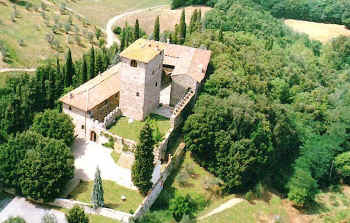
The Castle of Mugnana |
||
Castello di Mugnana in Chianti near Chiocchio |
||
Mugnana Castle |
|
The Castle of Mugnana, near Chiocchio, represents a typical case of the transformation of a castle (actually, a fortified village complete with a parish church, dedicated to San Donato) into a single-family, private residence. This took place at the moment when, during the 14 C, the structures of Mugnana castle, along with those of Sezzate castle, its neighbour opposite across the valley, became part of the assets of the Bardi family of Florence. The castle tower, originally 60 m high, and the current large curtain walls have been attributed (perhaps wrongly) to the Bardi. However, all of these structures existed in one form or another prior to the 14 C. The height of the tower was reduced when the advent of artillery rendered high towers a liability. |
Mugnana Castle was damaged during the siege of Florence (1530) and also in 1896, when an earthquake caused the destruction of the upper part of the watch tower, further reducing its height. |
More about the Castles of Chianti.
Chiocchio © ammonet InfoTech 2005 - 2020. All rights reserved.